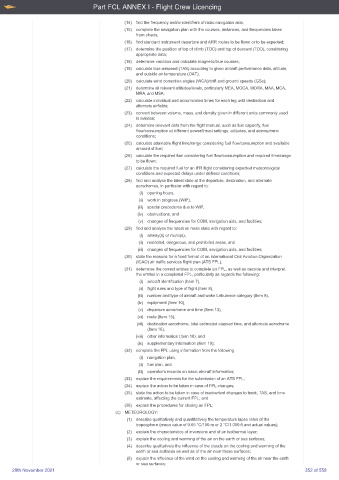Page 352 - UK Aircrew Regulations (Consolidated) 201121
P. 352
Part FCL ANNEX I - Flight Crew Licencing
(14) find the frequency and/or identifiers of radio navigation aids;
(15) complete the navigation plan with the courses, distances, and frequencies taken
from charts;
(16) find standard instrument departure and ARR routes to be flown or to be expected;
(17) determine the position of top of climb (TOC) and top of descent (TOD), considering
appropriate data;
(18) determine variation and calculate magnetic/true courses;
(19) calculate true airspeed (TAS) according to given aircraft performance data, altitude,
and outside air temperature (OAT);
(20) calculate wind correction angles (WCA)/drift and ground speeds (GSs);
(21) determine all relevant altitudes/levels, particularly MEA, MOCA, MORA, MAA, MCA,
MRA, and MSA;
(22) calculate individual and accumulated times for each leg until destination and
alternate airfields;
(23) convert between volume, mass, and density given in different units commonly used
in aviation;
(24) determine relevant data from the flight manual, such as fuel capacity, fuel
flow/consumption at different power/thrust settings, altitudes, and atmospheric
conditions;
(25) calculate attainable flight time/range considering fuel flow/consumption and available
amount of fuel;
(26) calculate the required fuel considering fuel flow/consumption and required time/range
to be flown;
(27) calculate the required fuel for an IFR flight considering expected meteorological
conditions and expected delays under defined conditions;
(28) find and analyse the latest state at the departure, destination, and alternate
aerodromes, in particular with regard to:
(i) opening hours,
(ii) work in progress (WIP),
(iii) special procedures due to WIP,
(iv) obstructions, and
(v) changes of frequencies for COM, navigation aids, and facilities;
(29) find and analyse the latest en route state with regard to:
(i) airway(s) or route(s),
(ii) restricted, dangerous, and prohibited areas, and
(iii) changes of frequencies for COM, navigation aids, and facilities;
(30) state the reasons for a fixed format of an International Civil Aviation Organization
(ICAO) air traffic services flight plan (ATS FPL);
(31) determine the correct entries to complete an FPL, as well as decode and interpret
the entries in a completed FPL, particularly as regards the following:
(i) aircraft identification (Item 7),
(ii) flight rules and type of flight (Item 8),
(iii) number and type of aircraft and wake turbulence category (Item 9),
(iv) equipment (Item 10),
(v) departure aerodrome and time (Item 13),
(vi) route (Item 15),
(vii) destination aerodrome, total estimated elapsed time, and alternate aerodrome
(Item 16),
(viii) other information (Item 18), and
(ix) supplementary information (Item 19);
(32) complete the FPL using information from the following:
(i) navigation plan,
(ii) fuel plan, and
(iii) operator’s records on basic aircraft information;
(33) explain the requirements for the submission of an ATS FPL;
(34) explain the action to be taken in case of FPL changes;
(35) state the action to be taken in case of inadvertent changes to track, TAS, and time
estimate, affecting the current FPL; and
(36) explain the procedures for closing an FPL;
(c) METEOROLOGY:
(1) describe qualitatively and quantitatively the temperature lapse rates of the
troposphere (mean value of 0.65 °C/100 m or 2 °C/1 000 ft and actual values);
(2) explain the characteristics of inversions and of an isothermal layer;
(3) explain the cooling and warming of the air on the earth or sea surfaces;
(4) describe qualitatively the influence of the clouds on the cooling and warming of the
earth or sea surfaces as well as of the air near those surfaces;
(5) explain the influence of the wind on the cooling and warming of the air near the earth
or sea surfaces;
20th November 2021 352 of 558

